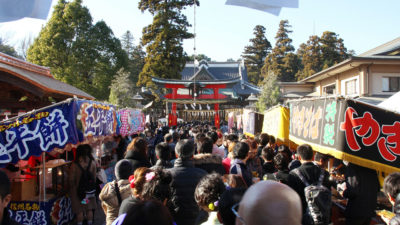Gastronomy Cycling Tour in Niigata: Day 1
For years I’ve been saying that my dream was to stay in one of Japan’s traditional inns, a ryokan. I wondered when my dream would finally come true.
We knew nothing about a region of Japan called Niigata, but an opportunity arose to join a tour and we jumped at it. Tokyo’s trees were still green but we were hoping that as Niigata was further north we’d be in time for a flashy show of autumn fall colors.
Japan’s fast trains are so civilized. On the Shinkansen from Tokyo to Niigata, I had more leg room that I knew what to do with and two hooks to hang the many coats I’d dragged with me. Sitting in a window seat, watching the scenery as the train headed north, my excitement began to mount as the foliage changed from greens to reds, yellows and oranges.
Mountains, each covered in a fur coat of colorful autumn leaves
Meeting our group at the train station, we put our luggage in a van and immediately hopped on bicycles. Winding roads along the river took us through rice paddies glistening like mirrors. The pace was slow and there were almost no cars, so I could relax and enjoy the vistas. That’s when I realized that we were surrounded by a circle of mountains, each covered in a fur coat of colorful autumn leaves.



I’d entered the real Japan.
Our always patient and smiling leader, Aki and jovial, knowledgeable guide, Bill, motioned for us to pull over in front of a small nondescript house. After removing my shoes, I looked up to see the quaintest, homiest Japanese restaurant that I could have conjured up, replete with an old granny chef, a TV blasting the news and plenty of tchotchkes. There was only one table and it had been set for our group with lots of small local dishes. My face expanded into a huge grin. I’d entered the real Japan.





Everything seemed aglow in yellow
On our bikes again after lunch, the clouds suddenly parted and light streamed down, bathing the mountains in gold bars of sun. The temperature rose and everything seemed aglow in yellow. We quickly stopped to take photos of the mountains and each other, knowing that light like that would make us all look like supermodels.




Temple in such a rural corner of Japan would be so chock full of priceless relics.
The road wound into a thick, dark, moist forest with bright green moss creeping up the trunks of the tall trees. Waiting for us was a small, old, bald man, a priest. He took us through a gate, into a garden surrounding a long, white walled temple with dark wooden beams. As we entered, we once again removed our shoes as he began to describe the temple’s collection. I was surprised that a temple in such a rural corner of Japan would be so chock full of priceless relics. But for me, the real joy was discreetly sliding open the white paper windows to peer out into the garden of red and yellow trees nestled-amidst the green forest. It looked like it had recently rained and the wind was picking up. Glistening orange leaves were wafting gently to the ground. I have no other way to describe the scene, than achingly beautiful.





Pickles made with fermented rice, a byproduct of sake.
We rode to a historic street, lined with shops hundreds of years old and toured a sake factory. Afterwards, it was getting dark and we headed into town. As had become the norm, we parked our bikes without locking them, hanging our helmets on the handle bars. We were there to meet a woman and her daughter who were selling pickles made with fermented rice, a byproduct of sake. After demonstrating how they make the pickles they lead us to the back of the store and up a steep dark wooden staircase. We were ushered into a warmly lit room covered in pale yellow tatami mats. Sitting cross legged on thin cushions at a low, shiny dark wooden table, we were served aromatic green tea in porcelain cups. Then came the pickles. I love pickles, but I wasn’t sure how I’d feel about these. Their most popular product is made from a vegetable similar to spaghetti squash. Hesitantly lifting the toothpick to my mouth, I bit into the amber segment of squash. It was satisfyingly crunchy and the salty, sweet, gamey flavor was sublime. I made a mental note to buy some before leaving the shop.



Ryokan, a centuries old dark wood building with paper doors and an onsen.
Now it was time to check into our hotel. I didn’t know what to expect. As we rode up. I couldn’t contain my excitement. It was a ryokan. A centuries old dark wood building with paper doors and an onsen, a Japanese bath. But this was not just any ryokan, it had recently been renovated incorporating whimsical artsy touches. I was in heaven.








Dressed in the yukata.
I wasn’t sure what to expect from dinner at a modern/traditional ryokan. Dressed in the yukata, casual cotton robes, provided for us, we were lead into a contemporary style dining room with floor to ceiling windows, overlooking the ponds and gardens. A long thin paper menu was placed next to each seat. I scolded myself for forgetting to bring my reading glasses, until I realized that no choices needed to be made, we would be served all of the mouth watering courses. Like our lunch, the restaurant took advantage of Niigata’s bounty of seasonal produce, like mountain picked mushrooms, pumpkin and lotus root.













The once in a life time moments of the day.
After a long, lavish dinner, I headed off to the onsen. Once again, I was in the company of Japanese grannies, this time they were stripped naked and so was I. We all showered before stepping outside into the freezing night air and then slipping into the steaming hot water of the rock pool. As I luxuriated, listening to them giggle and chat, I gazed up at the sky, recalling the once in a life time moments of the day.
That night my ryokan fantasies came full circle. I returned to my room to find that a traditional Japanese floor mattress, a futon, had been laid out for me on the tatami mats. As I nestled inside the fluffy duvet I was amazed how warm and cozy it was.

That was just day one. What would the rest of the three day tour have in store? I couldn’t wait to find out.
Ninja Reporter : Pam Kitt
 0
0























